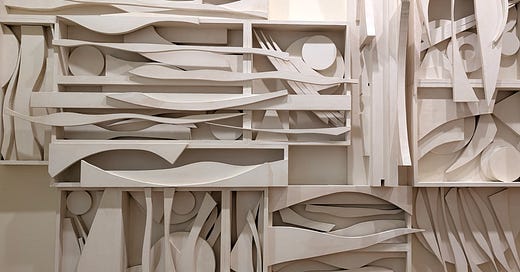Architecture tourist (wk 19/25)
Product and service strategy; amorphous consulting; Guastavino arches; Chinese Rooms and vampirism; Louise Nevelson on the wall.
Hello friends,
Another week spent underwater. I’ve a) been buried in last-minute work, b) failed to fully transition idk to new logistics providers, c) finally finished filing taxes, and c) been trying to set up a bunch of neat projects in June and August as part of a research fellowship with MOD and the University of South Australia.
Writing
I’ve been working with two teams from a global economic development agency on their offerings strategy. A big part of what they do is work with countries to explore and better articulate what their development challenges are. Their approach tries not to begin with assumptions about what the development challenges are; instead, they aim to be open, responsive, and adaptive to what they discover. This kind of work is a high-touch human service offering, not a product. So I wrote a bit about how to think about the differences between products and services, and what happens when you try to offer a product when a service would be more appropriate (or vice-versa).
👉 Read about how to think more strategically about products and services.
The work on products vs services reminded me of something I wrote last year, about how loosely defined, exploratory, scoping-oriented consulting helps clients find and understand problems that they don’t even have words for yet. This kind of “amorphous consulting” (my term) is especially valuable for clients in uncertain environments, but is always hard to sell compared to concrete consulting (which is easily comprehensible, highly legible, and easily scoped at the outset). Amorphous consulting, by its very nature, must only be offered as a service.
👉 Read about amorphous consulting.
Elsewhere
I’ve been stealing time to read Peter Watts’s Blindsight. I’m only 15% in, but the book has already used an alien first contact situation to consider artificial intelligence, transhumanism, consciousness and Chinese Rooms, the failures of game theory, vampirism, and neurotypicality. I think it’s going to be a good one.
Early this week, I finally went to St Peter’s Church. The church is tucked under one corner of the Citigroup Center, a rectilinear, 59-storey office building occupying an entire city block on the corner of East 51st Street and Lexington Avenue. To accommodate the church’s location, the Citigroup Center’s massive support columns come down to the ground in the middle of each of the four faces of the building instead of at the corners. The year after construction was completed, an architecture graduate student discovered that this unusual column placement made the building vulnerable to strong winds. The vulnerability had been overlooked in the structural engineering process, so the already-occupied building had to be retrofitted stealthily. There’s a great long read in the New Yorker about it. But I also wanted to visit the Church for the modular reconfigurable furniture by Lella and Massimo Vignelli, and the chapel filled with assemblages by Louise Nevelson.
See you next week,
VT






